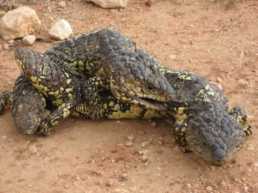The Australian Geographic Society writes about on their blog.
Some more details about the project:
Long term monogamy in the sleepy lizard, Tiliqua rugosa.
Males and females usually have different reproductive interests resulting in sexual conflict. Hence, monogamy, the mating of one male with one female, is very intriguing and is often selected for by the necessity of bi-parental care.
Monogamy is most common in birds but very rare in lizards, with the sleepy lizard probably one of the best studied species. Furthermore, sleepy lizards are not only monogamous within one mating season but remain with the same partner for many years, often decades. Interestingly overt parental care is absent in this species. This provides a great research opportunity and may improve our understanding of monogamy.
I am, in collaboration with some colleagues, currently investigating the long-term monogamy in the sleepy lizard in a project that is supported by the Australian Geographic Society. The main question our work revolves around is whether pairs that have been together for many years differ in their pair bond from relatively new pairs. During the last field season I collected very detailed pair behaviour data which we will combine with the exceptional dataset of Mike Bull, who is running a long-term survey on this species since 30 years, and has generated some intimate knowledge of many pairs.
This promises to give us some tremendous new insight into the long-term monogamy of this species. Stay tuned for some further progress.

Sleepy Lizard, Tiliqua rugosa












